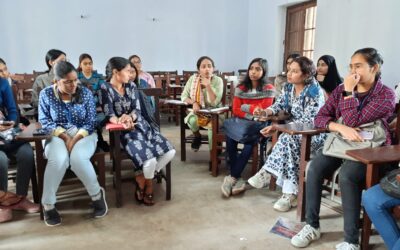“What has been the impact of the lockdown on children?” – the question popped up in the chat-box of an online webinar I was listlessly sitting through a few months ago, a time when the world was only beginning to grow accustomed to Zoom classrooms, office meetings and panel discussions. It naturally went to the developmental psychologist on the panel. What followed were hypotheses speculating over the potential impact on development of children by way of limited access to critical agents of socialisation such as peers or teachers.
Not long after, I took a flight despite the pandemic, moved to the hinterland of Southern Rajasthan and began my fellowship journey. In the days and weeks that followed, I found myself thinking again of the question. Except this time, I was concerned about a more specific category – children from under-served, rural spaces.
How different is the answer to the question that was posed in that webinar, when one looks beyond the privileged “upper” castes and classes that predictably became the only population the response revolved around?
There is, of course, the setback in education in spaces where access and quality have already been an issue for the longest time. On one hand, the pandemic and the subsequent shutting of schools had meant a shift to days filled with anywhere between three to six hours of online classes on mobile phones and tablets for most privileged, city dwelling kids. On the other, digital divide had obviously meant that there would be no such thing keeping children occupied in rural spaces.
In communities within Southern Rajasthan where I'm working, with typically a predominant Scheduled Caste (ST) population, no classes in any form have happened in the nine months since March, 2020. But this, I would argue, was one of the more visible, even obvious, effects of the lockdown.
In the months when the world was still settling into the new reality of a pandemic and the subsequent lockdown, there was much talk over how the damage done by it would be disproportionately distributed across communities. A part of that discourse led to predictions that the economic and social shocks produced by COVID-19 would hit children from vulnerable communities particularly hard.
Twitter and Instagram feeds soon saw at least one mention of digital divide turning fatal for students without access to technological resources. And with that, conversations around digital divide were briefly offered some limelight. Unfolding around the same time was yet another implication of the lockdown on children from vulnerable communities, one that is yet to receive a similar push into mainstream discourses — the increasing rates of child labour.

According to this article for instance, during the lockdown, child labour among school going children in West Bengal increased by a whopping 113% among girls, and by 94.7% among boys. In Rajasthan, statistically one of the biggest contributors of children for the labour markets of Gujarat and elsewhere, social organizations and social workers on ground have intervened and stopped hundreds of buses carrying children being trafficked for work.
In the six months post the lockdown, the national Childline recorded over 27 lakh distress calls, and over 1.92 lakh interventions on the ground. How drastically these statistics would change if we were to take into account the cases for which no reports were made, or all the unstopped buses, is perhaps anyone’s guess at this point in time.
Aside from the economic vulnerability created by a sudden loss of livelihood among vulnerable families, narratives I’ve gathered as part of my work with Aajeevika Bureau, a labour rights organization based out of Southern Rajasthan, largely point to how the sudden rise in rates of child labour is also attributable to the post-pandemic disruptions in schooling. While the lockdown was eventually lifted, and travel restrictions loosened up, schools still remained shut, with little certainty on when they would open up again. As the movement of migrant workers back to the states they worked in re-started, going along for the first time were children and teenage boys, who had formerly been school going.
While it is true that this trend was more strikingly visible across families that would obtain a higher score on the vulnerability index — such as single parent households, families with large amounts of debt, or within households with orphaned children (in the districts where I work, the death of both parents by TB is not uncommon) — it is by no means unique to families with such severe vulnerabilities.
Interesting insights emerge as one delves deeper into the why of child labour. The easily perceived, surface level, or even the slightly reductionist response, is of course poverty. Less explored however, are the aspects of socialisation and normalisation produced within economically vulnerable and under-served communities.
In most communities with high rates of child labour, a 14 or 15 year old dropping out of school and going to work is the “normal”. These are in fact the ages at which the lines on graphs mapping school drop out rates become steeper. While the no-fail policy keeps children enrolled in schools till 8th grade, failure rates in subsequent grades (high due to the meagre quality of education up until then), correlate with the drop-out rates.
When a child fails, families perceive little incentive for sending them back to school. Instead, putting them to work at the earliest, in markets where wage rates are more often than not dependent on the number of years of experience, is the more sensible thing to do. Factors like normalisation and socialisation enter the scene when this is all that one observes happening within their community.
“Yahan par padhai ka mahol hi nahi hai,” a teacher at a local school here tells me. When I ask him to elaborate, he goes on to ask me — “would you have taken up higher education if you grew up in a place where you saw absolutely no one going to college or holding a formal job?” (translated)
The operation of factors like normalisation becomes apparent as one looks at variations among communities with similar socio-economic profiles. In fact, exploring geographical variations also reveals how there could be more than just socio-economic characteristics influencing socialisation. In communities within the Sabla block of the Dungarpur district of Southern Rajasthan for instance, observations and interactions revealed that the employment of adolescent girls in local markets and work sites is rather prevalent. However, about 30 kms from there, in Salumbar or Jhallara block of Udaipur, the prevalence of the same does not appear to be as high.
Why is the employment of young girls normalised in one community but not in the other despite visibly similar socio-economic profiles? This is little more than a glimpse into the fairly less explored complexities within efforts to understand the why of child labour. Understanding the ‘why,’ and the nuances embedded therein, is crucial to the design of interventions.
When the pandemic struck, agencies like the ILO advocated for direct cash transfers as an immediate measure to prevent economic vulnerability becoming a reason for the entry of children into the labour market. In India, we see an example of why such an approach perhaps isn’t as effective as thought to be. In rural Rajasthan, you’d find families that benefited from cash transfers as well as other emergency provisions like the doubling of ration quantity, who still ended up sending their kids to work in the aftermath of the lockdown.
However, before dismissing cash transfers, one can’t overlook the nitty gritty of its planning and implementation either. In India, the government decided that a meagre amount of Rs. 500 per month was enough to meet the basic needs of a family. Had this amount been higher and sufficient, would this have been an effective intervention capable of preventing a spike in the rate of child labour? Perhaps. Or perhaps not.
Regardless, in the context of more long-term and sustained measures to tackle the issue, what’s needed are more multi-faceted interventions from the government — one that widens and strengthens the social security net, while also addressing gaps in access to quality education and healthcare. What’s needed are also interventions that are sensitive to the specific needs of DBA (Dalit, Bahujan, Adivasi) communities, in place of damaging steps like this one.




0 Comments